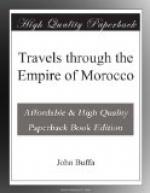Several remains of the European fortifications are yet visible; the Moors have repaired some, among which the western bastions still form a principal part of the strength of the place. The castle, which appears to have been built before the time of the Portuguese, stands in a commanding position upon one of the most prominent rocks of this coast. By an order of the Emperor, all the civil and military officers of this town are obliged to reside in it.
From this castle is a subterraneous passage containing many curious remnants of antiquity. On each side of the passage are ruinous apartments, which we may readily suppose to have been designed as places for the concealment of treasures, or receptacles for the dead. From the fragments of some urns I have collected, upon which are to be traced parts of inscriptions in the Punic character, I imagine this subterraneous place to have been built by the Carthaginians, for one or both of those purposes. It extends from the castle to several miles without the gates of the town; whence we may likewise infer, that it served as a means of escape in case of a sudden insurrection, or siege. Here are several superb mosques and commodious public baths.
The Socco, or market, is held twice a week (on Sunday and Wednesday), in a spacious sandy square, outside of the western gate, whereto the peasants bring all kinds of provisions, and other necessaries, which are sold at very low rates. Fish and every sort of wild fowl are brought in daily, and sold very cheap. Among the Consuls’ villas, some of which are built near the spot where the Socco is held, that of the Swedish Consul is the most worthy of notice. The pleasure-ground is laid out with great taste in orange groves; the gardens abound in fruit-trees, and the Consul has made a curious botanical collection.
I have just been interrupted by Mr. Matra, our Consul. He called to request me to go up to Larache, to attend the Governor, who is dangerously ill, and has sent here for an English physician. I intended to have continued a brief account of this empire, from the time it became a Roman province to the introduction of Mahometanism; also by what means the Moors became mixed with Arabs: but I must reserve this for the next opportunity.
LETTER II.
Sketch of the History of Morocco—Road from Tangiers—Simplicity of the Peasants—Moors hospitable—Arrive at a Village—The ancient Zelis—Public Accommodations—Much infested with Vermin—Arzilla, a ruinous walled Town—Arrive at Larache.
Larache, January 1806.
Before I proceed to give you the particulars of my journey to this place, I shall fulfil tho promise I made you in my last.




